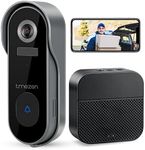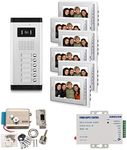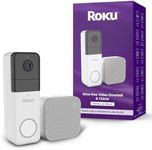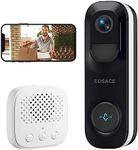Buying Guide for the Best Video Door Intercoms
Choosing the right video door intercom system can greatly enhance the security and convenience of your home or business. These systems allow you to see and communicate with visitors before granting them access, providing peace of mind and control. When selecting a video door intercom, consider the following key specifications to ensure you find the best fit for your needs.Video QualityVideo quality refers to the resolution and clarity of the image displayed on the intercom screen. Higher resolution provides a clearer and more detailed image, which is crucial for identifying visitors accurately. Video quality can range from standard definition (SD) to high definition (HD) and even ultra-high definition (UHD). If you need to clearly see faces and details, opt for HD or UHD. For basic identification, SD may suffice.
Screen SizeScreen size determines how large the video feed will appear on the intercom monitor. Larger screens provide a better viewing experience, making it easier to see details. Screen sizes typically range from 3.5 inches to 10 inches or more. If you prefer a more detailed view or have difficulty seeing small screens, choose a larger screen size. Smaller screens can be more compact and fit better in limited spaces.
Night VisionNight vision capability allows the intercom system to capture clear video in low-light or dark conditions. This feature is important for security during nighttime or in poorly lit areas. Night vision can be achieved through infrared (IR) LEDs or other technologies. If you need to monitor your entrance at night, ensure the system has good night vision capabilities. If your area is well-lit, this feature may be less critical.
Two-Way AudioTwo-way audio enables communication between the person at the door and the person inside the building. This feature is essential for verifying the identity of visitors and providing instructions or information. Look for systems with clear and reliable audio quality. If you frequently need to communicate with visitors, prioritize systems with excellent two-way audio. If communication is less frequent, basic audio may be sufficient.
ConnectivityConnectivity options determine how the intercom system connects to other devices and networks. Common options include wired connections, Wi-Fi, and Bluetooth. Wired systems are generally more reliable but can be harder to install. Wireless systems offer more flexibility and easier installation. Choose wired connectivity for stable performance, or wireless if you need convenience and flexibility.
Integration with Smart Home SystemsIntegration with smart home systems allows the intercom to work seamlessly with other smart devices, such as door locks, security cameras, and home automation systems. This feature enhances overall security and convenience. If you have or plan to have a smart home setup, ensure the intercom system is compatible with your existing devices. If you do not use smart home technology, this feature may not be necessary.
Durability and Weather ResistanceDurability and weather resistance are important for ensuring the intercom system can withstand various environmental conditions. Look for systems with robust construction and weatherproof ratings, such as IP65 or higher. If your intercom will be exposed to harsh weather, prioritize systems with high durability and weather resistance. For indoor or sheltered installations, this may be less critical.
Ease of InstallationEase of installation refers to how simple it is to set up the intercom system. Some systems require professional installation, while others can be installed by the user. Consider your comfort level with DIY projects and the complexity of the installation process. If you prefer a hassle-free setup, look for systems with straightforward installation instructions. If you are comfortable with more complex installations, you may have more options.




















